 Website:
Nonin
Website:
Nonin
Catalog excerpts
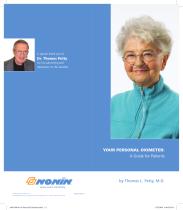
Dr. Thomas Petty for his authorship and dedication to this booklet. YOUR PERSONAL OXIMETER: A Guide for Patients by Thomas L. Petty, M.D. www.nonin.com/petty ©2009 Nonin Medical, Inc. All trademarks are the property of Nonin Medical, Inc. unless otherwise noted.
Open the catalog to page 1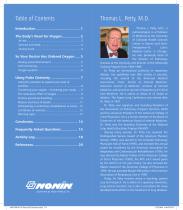
Thomas L. Petty, M.D., a pulmonologist, is a Professor of Medicine at the University of Colorado Health Sciences Center in Denver and RushPresbyterian-St. Luke’s Medical Center in Chicago. He was previously head of the Division of Pulmonary Sciences at the University and Director of the Fellowship Training Program from 1964-1989. Dr. Petty, an international authority on respiratory disease, has published over 800 articles in journals, including the Journal of the American Medical Association, Chest, Annals of Internal Medicine, American Journal of Medicine, Archives of Internal Medicine,...
Open the catalog to page 2
Introduction Today the use of Long Term Oxygen Therapy (LTOT) is best guided by personal measurements of oxygen levels in the blood, which are easily displayed by a simple, but sophisticated device that attaches to your finger, called an oximeter. This booklet explains the body’s need for oxygen, how oxygen delivery systems can provide oxygen, and how it’s monitored by a personal oximeter. You should always work with your doctor in your use of oxygen. LTOT is now established as an important treatment for patients with chronic oxygen deficits associated with Chronic Obstructive Pulmonary...
Open the catalog to page 3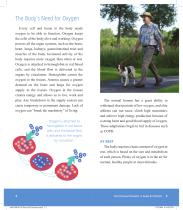
The Body’s Need for Oxygen Every cell and tissue in the body needs oxygen to be able to function. Oxygen keeps the cells of the body alive and working. Oxygen powers all the organ systems, such as the brain, heart, lungs, kidneys, gastrointestinal tract and muscles of the body. Increased activity of the body requires more oxygen than when at rest. Oxygen is attached to hemoglobin in red blood cells, and the blood flow is delivered to the organs by circulation. Hemoglobin carries the oxygen to the tissues. Anemia causes a greater demand on the heart and lungs for oxygen supply to the...
Open the catalog to page 4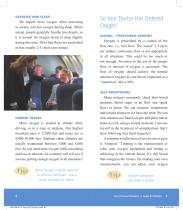
We require more oxygen when exercising or awake, and less oxygen during sleep. While asleep, people generally breathe less deeply, so it is normal for oxygen levels to drop slightly during this time. Most liter flows are prescribed at rest, usually 2-3 (liters) per minute. So Your Doctor Has Ordered Oxygen DOSING – PRESCRIBED AMOUNT Oxygen is prescribed by a control of the flow rate, i.e., liter flow. The “usual” 1-3 liters per minute continuous flow is not appropriate in all situations. This could be too much or not enough. Precision in the use of the proper flow, or amount of oxygen, is...
Open the catalog to page 5
PULSE OXIMETER Oxygen Saturation Pulse Rate setting for any situation, and with any LTOT device.3 Non-invasive measurement of oxygen saturation is made by a pulse oximeter. Ask for a prescription from your doctor. Oximeters, like blood sugar measuring devices, are sometimes reimbursed by health care insurance companies. OXYGEN SYSTEMS The ultra light ambulatory (wearable) liquid oxygen systems and the new low weight portable (“wheelable”) concentrators give oxygen settings by arbitrary numbers, such as 1-4 or 1-5. These refer to the size of the “pulses” of oxygen and are not the same as...
Open the catalog to page 6
CONSERVING YOUR OXYGEN – INCREASING YOUR RANGE Nail polish and/or artificial nails may affect the oximeter’s performance Nail polish that is very dark may interfere with the oxygen reading. If you are routinely measuring your oxygen saturation you may need to avoid these very dark shades. Light Emitting Diode Probe Body USING THE OXIMETER TO EXPAND YOUR LEVEL OF activities You can use your oximeter to measure your oxygen saturation level at any time, such as at home, at work or during recreation, i.e., playing golf. You can’t use it while actually swimming, since oximeters cannot be...
Open the catalog to page 7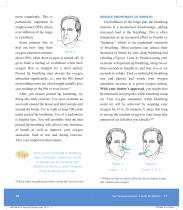
more completely. This is particularly important in emphysema/COPD, where over-inflation of the lungs is a problem. Some patients like to find out how long their oxygen saturation remains above 90% when their oxygen is turned off. It gives them a feeling of confidence when their oxygen flow is stopped for a short period. Pursed lip breathing may elevate the oxygen saturation significantly, i.e., into the 90s, based on breathing room air, which might initially give you readings in the 80s or even lower.* After you master pursed lip breathing, try doing this with exercise. Use your oximeter as...
Open the catalog to page 8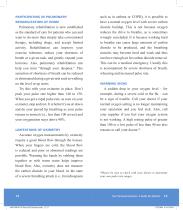
PARTICIPATING IN PULMONARY REHABILITATION AT HOME Pulmonary rehabilitation is now established as the standard of care for patients who can and want to do more than simply take conventional therapy, including drugs, and accept limited activity. Rehabilitation can improve your exercise tolerance, reduce your shortness of breath at a given task, and greatly expand your horizons. Also, pulmonary rehabilitation can help you train “through your dyspnea.” This sensation of shortness of breath can be reduced or eliminated during a given task such as walking on the level or up stairs. Try this with...
Open the catalog to page 9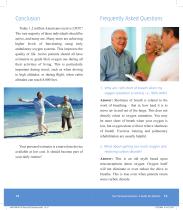
Frequently Asked Questions Today 1.2 million Americans receive LTOT.8 The vast majority of these individuals should be active, and many are. Many more are achieving higher levels of functioning using truly ambulatory oxygen systems. This improves the quality of life. Active patients should all have oximeters to guide their oxygen use during all their activities of living. This is particularly important during travel, such as when driving to high altitudes, or during flight, when cabin altitudes can reach 8,000 feet. 1. Why am I still short of breath when my oxygen saturation is normal,...
Open the catalog to page 10
3. Can I use a higher flow rate if I am short of breath while exercising? Answer: Yes, and it may be helpful in providing extra oxygen for your muscles as you are walking. You should return to your normal flow rate after exercise. Monitor your saturation during both rest and exercise with your oximeter. When walking 6. Can I re-adjust my oxygen dose myself? Answer: Work this out with your doctor. Certainly you should be able to adjust your oxygen just as people with diabetes adjust their own insulin, based upon measurements made at home. It is very important for you and your doctor to work...
Open the catalog to page 11All Nonin catalogs and technical brochures
-
SenSmart® 8006 Hybrid Sensor
2 Pages
-
WristOx2 ® Model 3150 USB
2 Pages
-
Unmatched Pulse Oximetry
2 Pages
-
NoninConnect Elite 3240
4 Pages
-
8204CA
4 Pages
-
8000 series
2 Pages
-
Narcotrend Compact-M
2 Pages
-
Unmatched Pulse Oximetry
2 Pages
-
9840/8500 Series
1 Pages
-
Onyx III 9591
2 Pages
-
6000 C series
2 Pages
-
USB-Desaturation
1 Pages
-
Capnography-for-CPR.
2 Pages
-
Nonin3230-3231
4 Pages
-
PalmSAT 2500 Brochure
2 Pages
-
Capnography Pain Management
2 Pages
-
CapnographyEMSTransport
2 Pages
-
RespSense
2 Pages
-
Why Nonin Sensors
4 Pages
-
PureSAT Advantage
2 Pages
-
Product Catalog
21 Pages
-
Avant 2120
2 Pages
-
Model 7500 Series
2 Pages
-
PureLight Sensors Brochure
2 Pages
-
3150 Sleep Flyer
2 Pages
-
LifeSense VET Brochure
2 Pages
-
Nonin Onyx Brochure
6 Pages
-
LifeSense®
2 Pages
-
9840 Series
2 Pages
-
WristOx 3100 Brochure
2 Pages
-
ipod Specifications
6 Pages
-
WIDESCREEN Pulse Oximeter
2 Pages
-
Vet Family Brochure
4 Pages
-
System Story Brochure
2 Pages
-
OEM Xpod Brochure
2 Pages
-
Avant® 9600
2 Pages
-
Onyx II, Model 9560 Brochure
3 Pages
-
Avant® 9700
2 Pages
-
Model 8500 Series
2 Pages
-
Capnography Use in Homecare
2 Pages
-
EQUANOX?, Model 7600
2 Pages
-
Flexi-Form ® III 7000 Series
2 Pages
-
Cloth 6000C Series
2 Pages
-
Onyx Vantage 9590
2 Pages
-
nVision
4 Pages
-
2500A VET Spec Sheet
2 Pages
-
PulseSense VET Brochure
2 Pages
-
RespSense VET Brochure
2 Pages
-
9847V Brochure
2 Pages
-
Model 8500AV Brochure
2 Pages
-
3150 Ambulatory Flyer
2 Pages
-
LifeSense®
2 Pages
-
WristOx2?
2 Pages
-
Model 7500
4 Pages
-
SpO2 Disposable Sensors
4 Pages
-
9500 Spec Sheet
2 Pages
-
Onyx® II 9550
2 Pages
-
Onyx9550
4 Pages
Archived catalogs
-
System Story Brochure Old
4 Pages
-
Vet Family Brochure Old
4 Pages
-
LifeSense® Old
2 Pages
-
Avant® 9600
1 Pages
-
Onyx® II, Model 9560
4 Pages
-
Product catalog
21 Pages

















































































